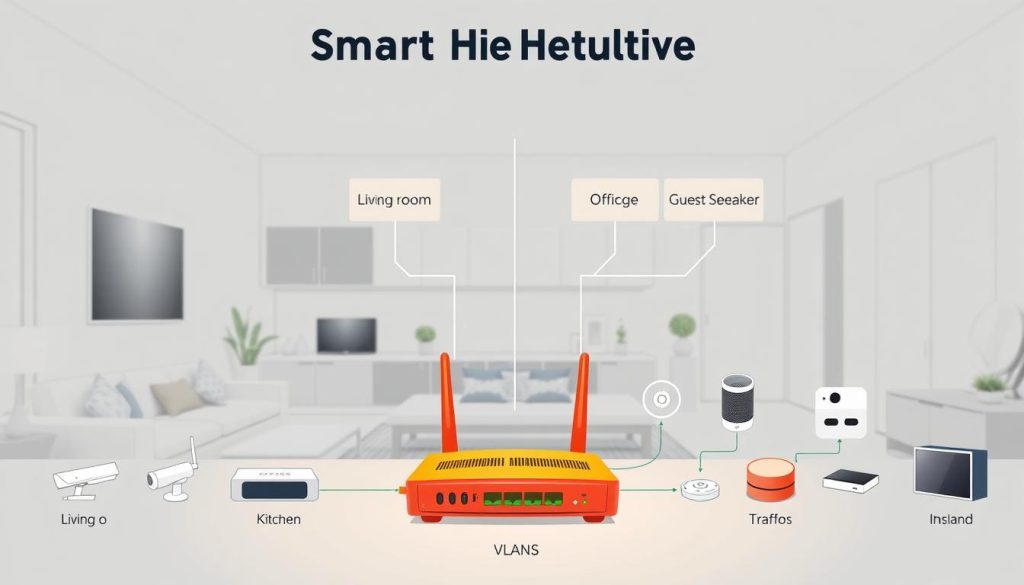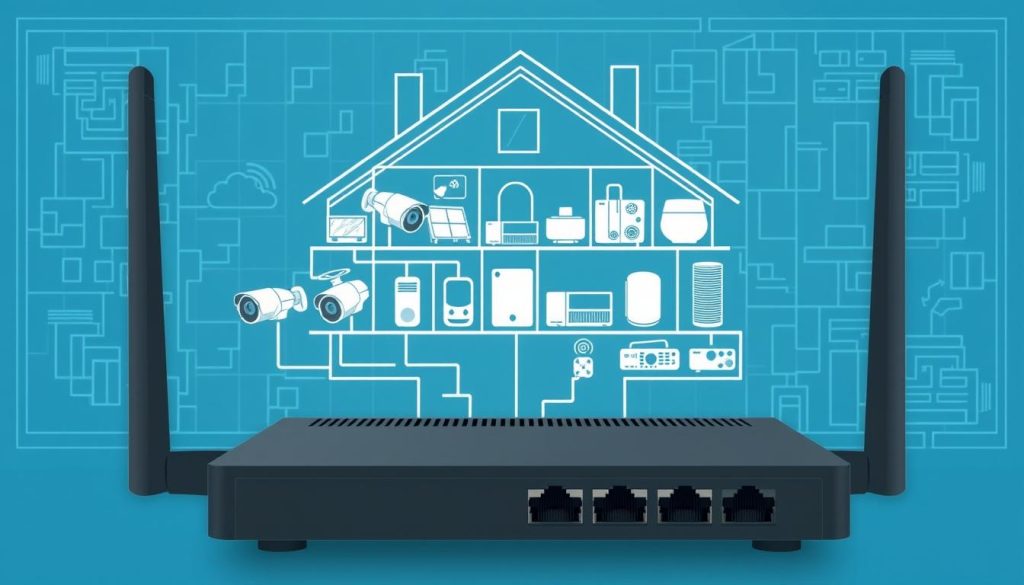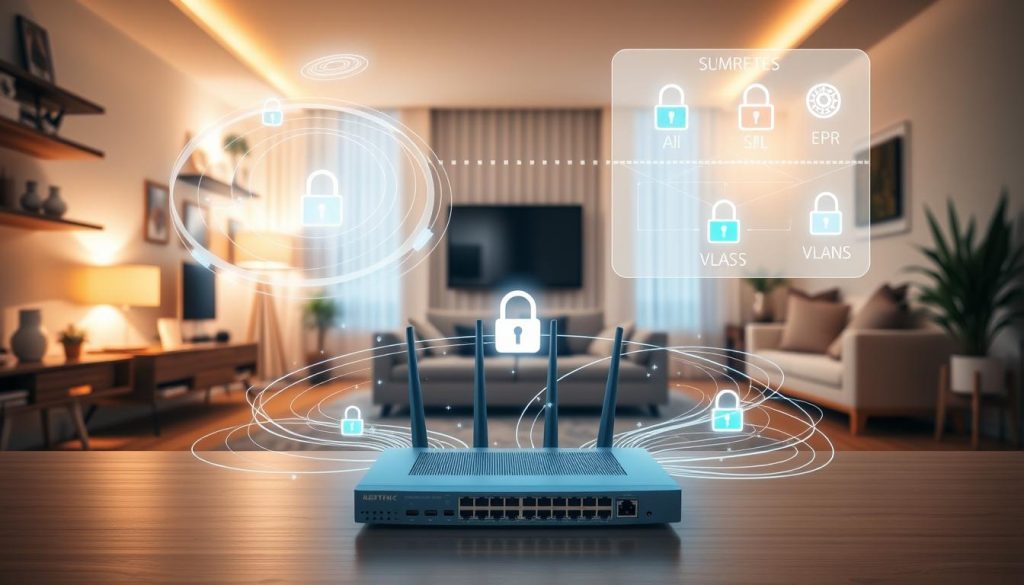Adding more smart devices to your home network raises the risk of cyber threats. Smart home devices are handy but can attract hackers if not secured well.
Using VLANs (Virtual Local Area Networks) and subnets boosts your smart home’s security. They keep devices in separate networks, stopping malware from spreading.
This setup is key to protecting your personal data and keeping your network safe from unauthorized access.
Key Takeaways
- Smart home devices increase vulnerability to cyber threats.
- VLANs and subnets can enhance smart home security.
- Isolating devices limits the spread of malware.
- Proper network configuration is crucial for security.
- Understanding IoT security best practices is essential.
Understanding VLANs: The Basics
Breaking your home network into smaller parts with VLANs boosts security and speed. VLANs, or Virtual Local Area Networks, split your network into segments. This is even if devices are on the same physical network.
What is a VLAN?
A VLAN is a virtual network part that isolates devices from each other. This is true even if they’re on the same switch or router. This isolation makes your network safer by stopping malware and unauthorized access.
Benefits of Using VLANs
Using VLANs in your smart home network has many advantages, including:
- Improved security through isolating sensitive devices
- Reduced network congestion by separating traffic
- Simplified network management by grouping related devices
How VLANs Work
VLANs assign a VLAN ID to each device or group on your network. Devices in the same VLAN can talk to each other. But, they can’t talk to devices in other VLANs unless there’s a route set up.
| VLAN ID | Device Type | Purpose |
|---|---|---|
| 10 | Smartphones, Laptops | General Use |
| 20 | Security Cameras | Surveillance |
| 30 | Smart Home Devices | IoT Devices |
By using VLANs, you can make your smart home network much safer and easier to manage.
What are Subnets?
To make your smart home network safer, it’s important to know about subnets. Subnets are parts of a network that are separate from others. This makes your network safer by stopping bad activities from spreading. Think of a subnet as a smaller part of your network, where you can group devices by their purpose or security needs.
Defining Subnets
A subnet is defined by a range of IP addresses and a subnet mask. Subnet isolation for home automation is key because it stops devices from accessing others unless you allow it. By making subnets, you can keep your smart home devices in different networks. This makes your network more secure.
Why are Subnets Important?
Subnets are crucial for smart home network segregation. They let you control how devices talk to each other. For example, you can put your security cameras on a different subnet from your entertainment devices. This lowers the chance of your security feed being hacked. Subnets also help manage network traffic better, as they limit broadcast domains.
Subnet Mask Explained
A subnet mask is a 32-bit number that shows the network’s scope. It works with an IP address to define the subnet. The subnet mask tells your router which IP addresses are on the same network and which need to go to another subnet. Knowing how to set up a subnet mask is essential for creating subnets for home device security. By changing the subnet mask, you can adjust your network’s size. This improves both your network’s security and performance.
The Security Risks of Smart Home Devices
Smart home devices are now a big part of our lives. But, they can be vulnerable to security threats. It’s important to know the risks and protect your devices.
Common Vulnerabilities
Smart home devices face many security risks. Weak passwords, outdated firmware, and insecure data transmission are common issues. For example, many devices have default passwords that hackers can easily guess. To stay safe, change these passwords and keep your devices updated.
Another big risk is when devices send data without encryption. This makes it easy for hackers to get your personal info. Make sure your devices use secure ways to send data to keep your smart home safe.
Impact of Poor Security
Poor security on smart home devices can lead to big problems. A hacked device can let hackers into your whole network. This could mean losing your personal data, money info, and even control over your devices.
Imagine a hacker taking over your security cameras or door locks. This shows why you need strong security, like using VLANs to keep devices safe and separate from others.
Notable Smart Home Security Breaches
There have been many smart home security breaches. For example, the Mirai botnet attack in 2016 used weak passwords to launch a huge DDoS attack. Recently, hackers have used smart home device flaws to listen in on users and get into home networks without permission.
These examples show why you need to update your devices regularly, use strong passwords, and keep your network safe. By understanding the risks and taking action, you can make your smart home much safer.
The Importance of Segmentation
Network segmentation is key to keeping your smart home devices safe. It divides your network into smaller parts. This makes it harder for a security breach to spread.

What is Network Segmentation?
Network segmentation breaks down a network into smaller segments. Each segment has a group of devices. This makes managing your smart home network easier. Smart home network segregation helps group devices by function or security level.
Enhancing Security with Segmentation
Segmentation boosts security by stopping malware and unauthorized access. If a device in one segment gets hacked, the damage stays there. This is crucial for VLAN security for smart devices, keeping breaches isolated.
Segmentation vs. Isolation
Segmentation and isolation both improve security, but differently. Isolation cuts off a device or group from the network. Segmentation divides the network into segments. Segmentation offers a balance between security and manageability, giving you finer control over network traffic.
In summary, network segmentation is a strong security tool for your smart home. By using segmentation, you can better protect your devices and data.
How VLANs Improve Smart Home Security
VLANs are great for smart home security. They create separate networks for different devices. This stops malware from spreading and keeps devices safe from unauthorized access.
Isolating Critical Devices
Isolating key devices on separate VLANs keeps them safe. For example, you can put your smart home security cameras and door locks on a special VLAN. This way, even if another device gets hacked, your important devices stay safe.
Creating Separate Networks
VLANs also help by making separate networks for different devices. You can have one for IoT devices, another for personal stuff, and a third for guests. This makes managing your network easier and safer.
Benefits of Separate Networks:
- Less chance of malware spreading
- Better network traffic control
- More secure for important devices
- More control over who can access what
Managing Traffic More Efficiently
VLANs also make managing network traffic easier. By separating devices, you can control how much bandwidth each gets. This boosts network speed and makes sure important devices get enough bandwidth.
To get the most out of VLANs, set them up right and keep an eye on your network. This way, you can keep your smart home devices safe and your network secure.
Implementing Subnets for Device Isolation
Subnetting is a great way to keep your smart home network safe. It lets you divide your network into smaller parts. This makes it easier to protect important devices from threats.
Planning Your Subnet Structure
First, you need to plan your subnet structure. Decide how many subnets you need and how many devices each will have. Think about the devices you have and how secure they need to be. For example, you might put your security cameras in one subnet and your computers in another.
Key considerations when planning your subnet structure include:
- Number of devices on your network
- Types of devices and their security needs
- Future expansion plans for your network
Assigning IP Addresses
After planning, assign IP addresses to your devices. You can do this statically or dynamically with DHCP. Dynamic assignment is easier, as it doesn’t require manual setup for each device.
Best practices for IP address assignment include:
- Using a consistent IP addressing scheme across your subnets
- Reserving certain IP ranges for specific types of devices
- Documenting your IP address assignments for future reference

Routing Between Subnets
Routing between subnets is key for device communication. Your router must be set up to handle this. You can use static or dynamic routing protocols.
Key aspects of routing between subnets include:
- Configuring your router to allow inter-subnet routing
- Setting up firewall rules to control traffic between subnets
- Monitoring and managing inter-subnet traffic for security and performance
By planning your subnet structure, assigning IP addresses, and setting up routing, you boost your smart home network’s security and efficiency.
Practical Steps to Set Up a VLAN
Setting up a VLAN is easy and makes your smart home safer. You’ll need to know what equipment and steps to take.
Required Equipment
To start, you need a few things. First, a router that supports VLANs. Not all routers can do this, so check your router’s specs or manual. You also need devices to isolate, like smart home gadgets.
- A VLAN-capable router
- Smart home devices (e.g., security cameras, smart thermostats)
- A computer or mobile device for configuration
Configuring Your Router
Configuring your router involves a few steps. You’ll need to access the router’s web interface, create VLANs, and assign devices. The steps can vary based on your router’s brand and model.
Here’s a general guide:
- Log in to your router’s web interface using its IP address.
- Navigate to the VLAN settings section.
- Create new VLANs and assign devices to them.
- Save your changes and reboot your router if needed.
Testing VLAN Functionality
After setting up VLANs, test them to make sure they work. Check that devices in one VLAN can talk to each other but not to devices in other VLANs.
| VLAN ID | Devices Assigned | Expected Isolation |
|---|---|---|
| VLAN 10 | Smart Security Cameras | Isolated from VLAN 20 |
| VLAN 20 | Smart Thermostats | Isolated from VLAN 10 |
By following these steps, you can set up a VLAN to boost your smart home’s security. Always check and update your VLAN settings to keep your home safe.
Using Subnets in a Smart Home Network
Subnetting helps keep your smart home network safe by isolating devices. It makes your network more secure, easier to manage, and faster. By dividing your network into subnets, you can protect your devices better.
Setting up Subnets in Your Router
To start, you need to get into your router’s settings. Just type your router’s IP address into a web browser. Then, find the LAN or advanced settings to set up your subnets.
Key Steps:
- Log in to your router using its IP address.
- Navigate to the LAN or advanced settings.
- Configure the subnet mask and IP range for each subnet.
- Save your changes and reboot the router if necessary.
Device Assignment to Subnets
Once your subnets are set up, you need to assign devices to them. You’ll need to set each device’s IP address and subnet mask. You can choose based on the device’s purpose or how secure it needs to be.
For instance, put all IoT devices on one subnet. Then, put servers or security cameras on a more secure subnet.

Monitoring Network Performance
It’s important to watch how your network is doing after setting up subnets. Make sure subnetting isn’t slowing things down or causing problems. Most routers have tools to help you keep an eye on network traffic and device status.
| Monitoring Task | Description | Tool/Method |
|---|---|---|
| Traffic Analysis | Analyze network traffic to identify bottlenecks. | Router’s built-in traffic analysis tool |
| Device Status | Check the status of devices connected to each subnet. | Router’s device list or network scanning tool |
| Performance Metrics | Monitor metrics like latency and packet loss. | Network monitoring software |
By setting up subnets right, assigning devices wisely, and keeping an eye on performance, you can make your smart home network much safer and more efficient.
Best Practices for VLANs and Subnets
When setting up VLANs and subnets for your smart home, following best practices is key. It boosts your network’s security. Managing these network parts well is essential to keep your devices and data safe.
Regularly Update Firmware
It’s crucial to keep your network devices’ firmware updated. Regular updates give your devices the latest security patches. This reduces the chance of hackers finding vulnerabilities.
Periodic Security Audits
Doing regular security audits is important. It finds weak spots in your VLAN and subnet setups. These audits let you fix issues early, keeping your smart home network safe.
Backup and Recovery Plans
Having a backup and recovery plan is essential. It helps you quickly get your network back if something goes wrong. This way, your smart home devices stay accessible and secure.
By sticking to these best practices, you can make your smart home network more secure and reliable. Remember, the secret to good VLAN and subnet management is regular upkeep and staying alert.
Advanced Features for Enhanced Security
To make your smart home network even safer, think about adding advanced features to VLANs and subnets. These features add an extra layer of protection for your devices and data.
Using Firewalls with VLANs
Firewalls are key for network security. They work well with VLANs to block unwanted traffic. This keeps your network safe from unauthorized access.
By setting up firewall rules for each VLAN, you can enhance the security of your smart home devices. This stops harmful activities from happening.
You can also limit access to certain VLANs. This keeps sensitive devices safe from risks. It’s great for protecting smart home devices with VLANs that handle important information.

Implementing VPNs for Remote Access
Virtual Private Networks (VPNs) offer a safe way to access your smart home network from anywhere. They encrypt your internet connection, keeping your data safe. Using a VPN is especially useful for secure smart device connections.
When picking a VPN, make sure it works with your router and supports your devices. This lets you securely access your smart home network from anywhere, knowing your data is safe.
Intrusion Detection Systems
Intrusion Detection Systems (IDS) watch your network for strange activity and alert you to threats. By adding an IDS to your VLANs, you can enhance your network’s security. This helps you act fast if there’s a breach.
An IDS can spot issues that firewalls or VPNs might miss. It gives you a full view of network segmentation for smart homes. This lets you take steps to keep your network and devices safe.
Common Challenges and Troubleshooting
Setting up VLANs and subnets for your smart home network can be tricky. You might face several common challenges. Knowing how to solve these problems is key to a secure and efficient network.
Issues with Device Compatibility
One big challenge is making sure all devices work with VLANs and subnets. Some devices might not support VLAN tagging or need special settings to work right.
- Check device specs to see if they support VLANs.
- Set up devices with the right subnet mask and IP address range.
- Keep device firmware up to date to fix compatibility problems.
For example, some older smart home devices might not work with the latest VLAN standards. You might need to upgrade or find a workaround to get them working.
Network Performance Issues
Network performance can suffer if VLANs and subnets aren’t set up right. This can cause problems like latency, packet loss, or trouble accessing resources.
To fix these issues:
- Watch network traffic to find bottlenecks.
- Adjust Quality of Service (QoS) settings to focus on important devices.
- Make sure routing between subnets is smooth to avoid congestion.
| Issue | Cause | Solution |
|---|---|---|
| Latency | Poor QoS settings | Adjust QoS to prioritize critical traffic |
| Packet Loss | Network congestion | Optimize routing between subnets |
| Inability to access resources | Incorrect subnet mask or IP range | Verify and adjust subnet configurations |
Troubleshooting Tips
When you’re troubleshooting VLAN and subnet problems, a step-by-step approach is best. First, figure out if the issue is with a device or the whole network.
Key troubleshooting steps include:
- Double-check VLAN and subnet settings.
- Look for firmware updates on devices and routers.
- Use network diagnostic tools to spot problems.
Regularly reviewing and updating your network setup can prevent many issues. Also, make sure your network gear works with your VLAN and subnet plan.
By knowing the common challenges with VLANs and subnets, and using systematic troubleshooting, you can keep your smart home network secure, efficient, and high-performing.
Future Trends in Smart Home Security
Looking ahead, new technologies will be key in keeping your smart home safe. AI and machine learning will boost security by spotting threats early and acting fast.
Advancements in Security Technologies
Network segmentation is a smart move for your home. It keeps important devices safe and stops hackers from spreading. Watch for new tools like advanced firewalls and intrusion detection systems.
Staying Ahead of Threats
It’s vital to keep up with smart home security updates. By using the latest tech and practices, you’ll have a safe and connected home.

